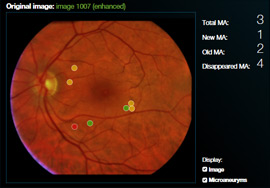The turnover of microaneurysms in the early stages of diabetic retinopathy (DR), according to data from a recent prospective study, may be an important indicator of how far the disease will progress.
The relationship between microaneurysms and diabetic retinopathy
Every eye on the debut of the Diabetic Retinopathy (RD), depending on its specific phenotype, has a different risk coefficient for developing clinically significant central macular oedema and the turnover of microaneurysms can have a higher predictive meaning than simply counting them.
Systemic markers of diabetessuch as hyperglycaemia or glycosylated haemoglobin, are not useful in identifying which cases of diabetic retinopathy are most likely to progress. In addition, under very similar conditions of metabolic control, some patients progress to thediabetic macular oedemawhile others remain affected only by retinopathy.
A prospective, multicentre study, published in the British Journal of Ophthalmology, on retinal microaneurysms recruited 205 patients with type 2 diabetes, aged over 35 years, from clinical centres in Coimbra (Portugal) and Hyderabad (India). The patients had mild forms of non-proliferative diabetic retinopathy, from level 20 to 35 on the ETDRS (Early Treatment of Diabetic Retinopathy Study) scale. In the majority of patients, BCVA (Best-Corrected Visual Acuity) was above 20/25 on the ETDRS tables and glycated haemoglobin (HbA1c) was at 11%. The other inclusion criteria were that patients had not previously undergone laser treatment, intravitreal injections with anti-VEGF drugs or steroids; the absence of retinal vasculopathies, glaucoma or inadequate pupil dilation.

The presence of microaneurysms was detected by the researchers with the automated Retmarker DR system, which can examine two colour images of the fundus and includes an algorithm that compares the same portion of the retina at different visits. With this system, the researchers were able to calculate the number of microaneurysms that develop or disappear in each patient in the corresponding time interval.
The group of patients with the highest rate of microaneurysm turnover, with or without increased retinal thickness, had the highest risk of developing clinically significant central macular oedema.
Source
Pappuru RKR, Ribeiro L, Lobo C, et al. Microaneurysm turnover is a predictor of diabetic retinopathy progression. Br J Ophthalmol. 2018 Apr 26. pii: bjophthalmol-2018-311887. doi: 10.1136/bjophthalmol-2018-311887
Dr. Carmelo Chines
Direttore responsabile
